pre-Socratic philosophy.
Cosmology and the metaphysics of matter
Because the earliest Greek philosophers focused their attention upon the origin and nature of the physical world, they are often called cosmologists or naturalists. Although monistic views (which trace the origin of the world to a single substance) prevailed at first, they were soon followed by several pluralistic theories (which trace it to several ultimate substances).
Pre-Socratic philosophy, in the history of Western philosophy, the cosmological and naturalistic speculations of ancient Greek philosophers who were predecessors or contemporaries of Socrates (c. 470–399 BCE). Among the most significant pre-Socratic philosophers are the Milesians Thales (c. 624–620—c. 548–545 BCE), Anaximander (610–546 BCE), and Anaximenes (flourished c. 545 BCE); Xenophanes of Colophon (c. 560–478 BCE); Parmenides of Elea (born c. 515 BCE); Heraclitus (also spelled Heracleitus) of Ephesus (c. 540–480 BCE); Empedocles of Acragas (c. 490–430 BCE); Anaxagoras of Clazomenae (c. 500–c. 428 BCE); Democritus of Abdera (c. 460–c. 370 BCE); Zeno of Elea (c. 495–430 BCE); and Pythagoras of Samos (c. 570—c. 500–490 BCE).
A N A X I M A N D E R postulated eternal motion, along with the apeiron, as the originating cause of the world. This (probably rotary) motion caused opposites, such as hot and cold,…

…That everything originated from the apeiron (the “infinite,” “unlimited,” or “indefinite”), rather than from a particular element, such as water (as Thales had held). Anaximander postulated eternal motion, along with the apeiron, as the originating cause of the world. This (probably rotary) motion caused opposites, such as hot and cold,…

The concept of infinity has been around long before its symbol. The Greek philosopher Anaximander (c. 610 – c. 546 BC) described the concept of apeiron, which means “unbounded.” Aristotle (350 BC) distinguished between different types of infinity. Euclid’s theorems referenced the concept. II N F I N I T Y … is anything endless. It refers to unending time, a series of numbers that continues forever, or a perpetual series of operations.

Eleaticism, one of the principal schools of ancient pre-Socratic philosophy, so called from its seat in the Greek colony of Elea (or Velia) in southern Italy. This school, which flourished in the 5th century BCE, was distinguished by its radical monism—i.e., its doctrine of the One, according to which all that exists (or is really true) is a static plenum of Being as such, and nothing exists that stands either in contrast or in contradiction to Being. Thus, all differentiation, motion, and change must be illusory. This monism is also reflected in its view that existence, thought, and expression coalesce into one.
The sources for the study of Eleaticism are both archaeological and literary. Archaeologists have ascertained that, at the time of Parmenides, the founder of the school, Elea was a large town with many temples, a harbour, and a girdle of walls several miles long. They have also unearthed a site presumed to be that of the medical school that Parmenides established and an inscription bearing Parmenides’ name.
The literary sources consist of fragments preserved by later classical authors. (The fragments are collected in their conventional numerical order in Die Fragmente der Vorsokratiker [1903], edited by Hermann Diels.) Of these passages, 19 are from Parmenides, 4 from his pupil Zeno, renowned for his paradoxes of motion, and 10 from another pupil, Melissus, an admiral of Sámos; all but 3 from Parmenides and 2 from Melissus are 10 lines or fewer in length. Naturally, any interpretation of the fragments must give due consideration to the biases of the citing authors. Parmenideans of the second generation, for example, saw their master, simplistically, only as the prophet of immobility; and the ancient Skeptic Sextus Empiricus distorted Parmenides’ thinking into problems of epistemology (theory of knowledge), because this is what his Skeptical eye saw in Parmenides’ writings.
The Eleatic school vis-à-vis rival movements
Each member of the Eleatic school espoused a distinctive variety of Eleaticism: Parmenides pursued a direct and logical course of thought and viewed Being as finite and timeless; Zeno concurred in Parmenides’ doctrines but employed the indirect methods of reductio ad absurdum and infinite regress (see below The paradoxes of Zeno); and Melissus modified the doctrines, viewing Being as infinitely extensive and eternally temporal. A fourth thinker, the Sicilian Sophist Gorgias of Leontini, though not an adherent of Eleaticism, employed the methods of the Eleatic Zeno to defend its opposite—a nihilism that affirmed Not-Being instead of Being.

ANXIMANDER PROJECTS AN IMAGE OF COSMIC BALANCE – A WORLD OF OPPOSING AND BALANCED FORCES
https://enneaetifotos.blogspot.com/2024/08/h.html?m=1
A compound phrase of Anaximander’s, which has come down to us as formulated by its speaker, is the earliest authentic material we have from the history of philosophy.
From whence the genesis is to these, and the decay in these is done according to the debts, for these give judgment and they are the members of injustice according to the order of time.
From where beings are born there and end up dying, as necessity dictates; for they answer and make amends to one another for the injustice they have committed, according to the order of time.
Anaximander, seconded 1
This text is written in prose, but maintains the rhythm and internal balance of the poetic expression. It brings us before a worldly court, where justice is meted out to certain “beings” for the injustice they have committed against one another. The familiar image of the political court comes to illuminate a distant and inaccessible secret of the order of the world. We do not know which beings Anaximander is talking about or what exactly their crime is, but we do know the punishment imposed on them: it is the necessary exchange of their birth and death.
Death is the return to the womb from which they were born and, since it is presented as a punishment, as a price they must pay “to each other”, then the offense is rather the very birth of one being which seems to have harmed another being. The fact that it is not precisely determined who wrongs and who is wronged, who makes amends and who is rewarded, shows that there is reciprocity, a reversal of roles in the court. The accused will later, “according to the order of time,” become the accuser – and this process will continue eternally.
It is certain that Anaximander projects here an image of cosmic balance. The administration of justice, the retribution of the unjust act, the mutual relationship of those involved and the alternation of their roles, the reference to Necessity and the order of time, all these are sure indications that lead us to the conception of the world as a system of contending and balanced forces. .
This image is strengthened if we consider that the “beings” of the passage refer to opposing elements or opposing forces. The word ‘being’ has not yet acquired its special philosophical meaning – in Homer ‘beings’ are simply existing things. Since beings are opposites, then we understand why the death of one is gain for its opposite. The death of the hot is the gain of the cold. And indeed it is not just a gain of the cold, but a predominance, a victory of the cold over the warm, a reward for the injustice that the cold had suffered with the birth of the warm.
The perpetual change of the world is a constant conflict and alternation of opposing forces: cold and heat, dryness and moisture, condensation and dilution, Winter and Summer. With the metaphor of the court, Anaximander hints that this apparent strife is ultimately justice, since no power ever completely prevails, but in the fullness of time there is balance—the births and deaths of opposites are eventually balanced. This is how the coherence and order of the World is maintained.
Source: https://www.greek-language.gr
IMAGE: The French dancer Daljell, photographed on the Acropolis of Athens by the Greek photographer Nelly’s (Elli Souyoultzoglou – Seraidari) in 1930. https://x.com

ARISTARHUS

ANCIENT GREEK ASTRONOMER ARISTARCHOS was the first, who DISCOVERED the HELIOCENTRIC SYSTEM, MAINTAINING THAT THE EARTH REVOLVES AROUND THE SUN.THE SAGES OF ANTIQUITY WERE DIVIDED BETWEEN THE ADVOCATES OF THE GEOCENTRIC THEORY OF THE WORLD AND THOSE OF THE HELIOCENTRIC THEORY. In OTHER WORDS, THE EARTH, ROTATES AROUND THE SUN..
ARISTARHUS of SAMOS: & HIS HELIOCENTRIC SYSTEMARISTARHUS was certainly both a mathematician and astronomer and he is most celebrated as the first to propose a sun-centred universe. He is also famed for his pioneering attempt to determine the sizes and distances of the sun and moon.There was a time when people thought that the earth was the center of the universe. Although Nicolaus Copernicus and Galileo Galilei got credit for this idea in the 1500’s, this theory was ACTUALY originated by the ANCIENT GREEK ASTRONOMER and MATHEMATICIAN known as ARISTARHUS of SAMOS. HERE`s MORE information about WHO was and his CONTRIBUTION to ASTRONOMY:Early Life of AristarchusAristarchus of Samos was born approximate 310 B.C in an area known as Samos, Greece. There are historical records that show his formal education took place in Alexandria. He eventually became head of the Greek educational system at Lyceum in Greece.Sun is at the CenterAristarchus is known for his revolutionary astronomical hypothesis. It was Aristarchus who initially put forth a theory of the Sun and not the Earth being the fixed center of the universe. It was his belief the earth and the other planets actually moved around the sun. Aristarchus also provided a theory on stars being distant suns. He claimed they did not move, and the universe was much larger than others could imagine.Inspired by Philolaus of CrotonAristarchus of Samos was inspired by the work of Philolaus of Croton, who put forth the idea that the cosmos existed because unlimited fire is found at the center of a cosmic sphere. This is the first person recognized as placing the other planets in their correct order as well as correct distance from the sun.Development of HypothesisThe written book “On the Sizes and Distances of the Sun and Moon” is the only known work that Aristarchus wrote. When he had completed this, Aristarchus felt presenting it would have not have benefited him since it was a contradiction to the general consensus of the Greek scientific community. His book was based on the observations made during a lunar eclipse. He determined the Earth’s shadow was twice the diameter of the Moon’s shadow. Aristarchus did record the Sun and Moon being two degrees when measured for an angular diameter. He was also able to show the angular distance between the Moon and sun during the time of quarter moon as 87 degrees.Implications of this TheoryMany modern scientists believe the hypothesis put forth by Aristarchus had other interesting aspects to it beyond all the planets in the universe rotating around the sun. With the use of geometry, he determined the Sun may be as much as 20 times farther away from the earth than the moon. His figures were not as accurate as such calculations would be by future astronomers. Aristarchus did use a sound geometric method for his calculations. This was the correct way to make such a determination. It was using this method that made more sophisticated and accurate celestial calculations possible.Aristarchus of Samos died in circa 230 B.C. He is recognized by most astronomers as someone who was advanced in his thinking and ideas for the time when he lived. Aristarchus of Samos did not get much recognition during his life for his work but he did achieve credit later on.The GREEKS SHOULD NEVER LEARN that: DEMOCRITUS , PYTHAGORAS, HERACLEITOS completely formulated the theory of NUCLEAR PHYSICS and SPECIAL RELATIVITY, unifying into single MATHEMATICAL(https://heptapolis.com/mathematics-greek-language), formulas, as ELECTRICITY, GRAVITY, MAGNETISM, ASTRONOMY, and the Weak Currents of NUCLEAR ATOMS.The Greeks MUST NEVER LEARN that: the ASTRONOMERS – MATHEMATICIANS: EUDOXUS, CALLIPOS , ARISTARCHOS, ANAXIMANDROS, EUKLIDES, ARCHIMEDES, CONON, HIPPARCHUS, CLEOMEDES, APOLLONIOS, PTOLEMY, THEON, HYPATIA, PAPPUS, had EXHAUSTED the LIMITS of human INTELLIGENCE by solving MENTALY WITHOUT GRAPHICAL REPRESENTATION equations of 12 unknowns (twelve equations twelve unknowns) while the limit of today’s computers is “7 equations 7 unknowns”. Because the THIEVES of ANCIENT KNOWLEDGE, AS: – KEPLER, GALILEO, COPERNICUS etc. MUST be SHOWN!! …The GREEKS SHOULD NOT KNOW that: the ENGINEERS – TECHNICIANS: EUPALINOS, SOSTRATOS, HERON, ZOSIMOS, KALLINIKOS, manufactured TOPOGRAPHIC instruments for TRIGONOMETRIC SURVEYING, AUTOMATIC mechanisms and instruments for ELECTRICAL applications, because the SWINDLER EDISON MUST be SHOWN as the INVENTOR of … ELECTRICITY, ALTHOUGH the above GREEK ENGINEERS used the ELECTRON (AMBER) as a NATURAL ACCUMULATOR of STATIC ELECTRICITY in technical applications…The Greeks MUST NOT KNOW that: the GEOGRAPHERS – EXPLORERS SKYLAX, PYTHEAS, EUDOXUS, STRABON, PAUSANIAS, COSMAS the INDIKOPLEISTIS, HECATAEUS, had mapped the ENTIRE surface of the planet, because there is a danger that the Greeks will learn that ATLANTIS and the AMERICAN CONTINENT belonged administratively in DELPHI, while Asia belonged administratively to SARDIS, with the central coordinator being the APOLLONIAN Center of DELOS, to which the Transborean Greeks (Northern Siberia) sent as a token of recognition “every year, choice grain”, through the Greek ARIMASPAS and ISSIDONES and MASSAGESTAEof Central and Southern SIBERIA.The Greeks should not know that the Greek DOCTORS, GALENOS, CELSIUS, HERACLIDES, HEROPHILUS, PRAXAGORAS, AGNODIKIS, KTIRIAS, HIPPOCRATES, ERIVIOTIS, carried out “balancing electromagnetic fluids of the body” treatments by regulating the alkalinity and acidity of the organs. That they were making cures using “left-handed amino acids” (antibiotics) obtained from plants, fully knowing that only recently did molecular biology discover the action-reaction of left-handed amino acids (antibiotics) with right-handed amino acids (organism proteins).The Greeks must not learn that the symbols “LEFT-CROWNED SWASTIKA” and “RIGHT-CROWNED SWASTIKA” were SYMBOLS of PHYSICS and MATHEMATICS, by which the Greeks PYTHAGORAS and DEMOCRITUS and ARISTARCHOS expressed right-handed and left-handed nuclei of atoms, planets, solar systems, galaxies and cosmic domains clusters of galaxies.2500 years ago HIPPOCRATES performed brain and heart surgery…Despite the almost non-existent means of his time, HIPPOCRATES performed difficult surgeries. He and his students successfully treated orthopedic, cardiac and basic surgery cases. HIPPOCRATES even performed operations on the human skull, as we read in several of his works… In addition to the operation itself, HIPPOCRATES attached great importance to the preparation of the patient and the operating room.In the work Kat’iatreion, he describes in detail how the patient should be prepared before the operation, how the tools are sterilized, how the space is shaped, but also how artificial and natural light is used during the operation…American archaeobotanists were able for the first time to study and analyze the contents of pills made by doctors in ancient Greece and which were discovered 20 years ago, in a Greek shipwreck off the coast of Tuscany…DNA analyzes showed that each pill was a mixture of at least ten different plant extracts, including hibiscus and celery. “For the first time, we now have physical evidence of what is contained in the writings of the ancient Greek physicians DIOSCORIDIS and GALENOS,” said ALLEN TWOWAY of the SMITHSONIAN INSTITUTION’s NATIONAL Museum of NATURAL HISTORY in WASHINGTON , according to New Scientist..Apostle ORPHEUS” ETYMOLOGY OF the NAME ROOT:ÁRISTOS ARKHḖ / ÁRKHŌ > ARÍSTARKHOSNATIVE NAME ROOT: GREEKÁRISTOS (ἌΡῘΣΤΟΣ) ARKHḖ (Ᾰ̓ΡΧΉ) ÁRKHŌ (ἌΡΧΩ) ARÍSTARKHOS (ἈΡΊΣΤΑΡΧΟΣ)MEANING: This name derives from the Ancient Greek name “Arístarkhos (Ἀρίσταρχος)”, composed of two elements: “áristos (ἄρῐστος)” (best, better, excellent, first-rate, thorough) plus “arkhḗ (ᾰ̓ρχή) árkhō (ἄρχω)” (beginning, origin, sovereignty, dominion, authority). In turn the name means “the perfect source, the right origin”. 1) Aristarchus of Samos (~310–230 BC) was an ancient Greek astronomer and mathematician who presented the first known model that placed the Sun at the center of the known universe with the Earth revolving around it. 2) Aristarchus of Samothrace (~220–143 BC) was a grammarian noted as the most influential of all scholars of Homeric poetry. He was the librarian of the library of Alexandria..
Aristarchus of SAMOS: The Greek thatThey “Forgot” to Mention as the Father of the Heliocentric Model.
His ideas on Astronomy were not initially accepted and considered inferior to those of Aristotle and Ptolemy, until they were successfully revived and developed by Copernicus some 2000 years later.
HELIOCENTRISM
However, we know from various references that Aristarchus had written another book in which he proposed the alternative hypothesis of the heliocentric model.
“Cleanthis, [a contemporary of Aristarchus] believed that it was the duty of the Greeks to condemn Aristarchus of Samia on the charge of setting in motion the hearth [center] of the Universe [i.e. the Earth] and thus disturbs the tranquility of the gods: “As you move the hearth of the world and disturb the tranquility of the Olympians (gods)” …, you assumed that the sky remains stationary and the Earth turns on an inclined circle, while at the same time revolving around from its axis.”
Size of the Moon distance and size of the Sun
He found that the Moon and the Sun are almost the same apparent size from Earth and concluded that their diameters would be proportional to their distance from Earth.
The rebirth of Aristarchus theory
Stobaeus in his collection “On Physics” writes: “Aristarchus ton Helion istisisi”.
Plutarch in his work “On the likes of the Philosophers” states:
“Aristarchus placed the Sun behind the plains, and the Earth moves around the solar circle, and the Earth evolves according to an oblique circle, if it is also rotated around its axis, and during these inclinations it shadows the disc”.
The only work of Aristarchus that has survived to this day, “On the sizes and distances of the Sun and the Moon” (On the sizes and distances of the Sun and the Moon), is based on a geocentric model.
Archimedes wrote: “King Gelon, you know that the world is the name that most astronomers give to a sphere, in the center of which is the Earth, and that the radius of this sphere is equal to the distance between the Sun and and the Earth. This is the explanation given by astronomers. But Aristarchus wrote a book, which contains certain propositions, from which it is concluded that the real world is much larger.
It is believed that the flat stars and the Sun are stationary, that the Earth moves around the Sun in a circular orbit, with the Sun at its center. Even though the sphere of the plain stars, which is at the same center as the Sun, is so large that the circle around which the Earth revolves is as far from the plain stars as the center of a sphere is from the surface of … Aristarchus means the following: since we believe that the Earth is, let’s say, the center of the world, the relationship of the Earth to what we call “the world” is equal to the relationship of the sphere, which contains the circle on which the Earth is said to revolve, towards the sphere of the plain stars.”
Hence, Aristarchus believed that the stars are infinitely distant, and he considered this to be the explanation for the absence of visible parallax, that is, the observed motion of the stars as the Earth moves around the Sun. In fact the stars are much further away than was assumed in ancient times, which explains the fact that stellar parallax is detectable only with telescopes. But it had been assumed that the geocentric model was a simpler and better explanation for the lack of parallax.
The rejection of the heliocentric view was apparently quite strong, as indicated by the following text of Plutarch (On the apparent face of the circle of the moon):
Aristarchus observed the movement of the Moon through the Earth’s shadow during a lunar eclipse. He estimated that the diameter of the Earth was 3 times the diameter of the Moon.
Using Eratosthenes’ calculation that the circumference of the Earth was 42,000 km, he deduced that the Moon has a circumference equal to 14,000 km. Today, the Moon is known to have a circumference approximately equal to 10,916 km.
of the last quarter of the Moon. He estimated the angle to be 87°.
Aristarchus observed/argued that the Sun, Moon and Earth form almost a right angle at the time of the first or last quarter of the Moon. He estimated the angle to be 87°.
Using correct Geometry, but incorrect observational evidence, Aristarchus concluded that the Sun was 20 times further away than the Moon. In reality the Sun is about 390 times further away.
So he concluded that the Sun was 20 times the diameter of the Moon, which is computationally logical and correct, but also wrong (since it is based on wrong data). But this estimate of his indicates that the Sun is clearly larger than the Earth, which supports the heliocentric model.
Aristarchus was the first to propose the currently accepted heliocentric theory and founded Astronomy on logical thought, a view which, unfortunately, a portion of the international astronomical community, either justified by ignorance or even unjustifiably, does not seem to share at all. Unfortunately for the heliocentric theory, ardent supporters of the geocentric theory, also introduced by Samius Pythagoras, were scientists of the stature of an Aristotle, a Hipparchus or a Ptolemy… Consequently, the revolutionary idea of Aristarchus could not be accepted.
It fell into oblivion without being completely forgotten until the Renaissance, when in 1543, about two millennia later, it was vindicated by the famous Polish astronomer Nicolaus Copernicus. Although Copernicus simply brought the heliocentric theory out of obscurity, thus repeating the ideas of Aristarchus, he is nevertheless regarded today as the proponent of the heliocentric theory, and the currently accepted heliocentric system is still internationally called “Copernicus” and not “Aristarchian”. , as it should be.
The survival of the heliocentric theory, despite the polemics of its opponents, is due less to Copernicus and more to the overwhelming proofs of its correctness, given from time to time by Galileo, Kepler, Newton et al. So, the question whether the work of Copernicus is original and what is its value arises easily.
In order to give a responsible answer to this question, one should take into account the difficulties of the age of Copernicus, during which the doctrines of Aristotle prevailed, with which no one was allowed to disagree. In addition, criticism of the Polish astronomer’s theories began immediately and was particularly intense.
Although Copernicus’s contribution to the revival of the heliocentric theory is important, this is not enough for him to be recognized as the author of this theory. It is true that Copernicus knew the views of Aristarchus. This is attested by a surviving manuscript fragment of his treatise De Revolutionibus Orbium Coelestium. In it, the paragraph referred to in Aristarchus’s treatise appears to have been deleted and which, paradoxically, was not included in the printed version of his treatise presented in 1543. The fact of the deletion is characterized by some as plagiarism, while others consider the omission of reference to Aristarchus also in his theory as lack of courage or cowardice.
However, it should be emphasized that it is not absolutely certain whether the erasure should be attributed to Copernicus himself or to his editor, given that the treatise was published after his death. It is also noteworthy that the Polish astronomer did not give his consent for the publication of his treatise for a whole decade, fearing the condemnation of the Roman Catholic Church.
Finally, in 1543, a copy of his manuscript was published in Nuremberg, which was condemned in 1616 by the Church of Rome.
Copernicus is therefore not the introducer but simply the man who brought out of oblivion and spread the heliocentric theory, the authorship of which belongs exclusively to Aristarchus. Copernicus’ contribution lies mainly in the fact that he introduced the geometric mechanism of Ptolemy’s geocentric system into the heliocentric system of Aristarchus. But it is evident that, since the real difficulty, namely, the belief that the planets move smoothly in circular orbits, could not be overcome, his whole effort was on the wrong track
.
For the restoration of the truth but also for reasons of historical self-awareness, the widest possible information is required on the work of the great Greek astronomer Aristarchus, as one of the leading figures in the world of Greek astronomers, mathematicians and philosophers of antiquity.
Archimedes in his mathematical treatise “Psammitis” writes: “Aristarchus the Samian is supposed to be because the plains of the stars and Alion remain motionless, while Gan revolves around Alion in a circular circumference, which is in the middle of the road text”.

- Konstantin
- On August 1, 2022
- https://euphoriatric.com


“Every known essence is excluded as the first principle of beings, because as long as it were known, it automatically ceases to be infinite” ANAXIMANDER Dikē, which refers to the concept of justice and to the Greek Goddess of Justice, was an important physical and metaphysical term in ancient philosophy. For ANAXIMANDER, the concept was concerned not only with ethical and formal laws, but also ontological laws; as a principle that governed how things come to be according to cosmic law. Dikē is the ultimate governing and ordering principle, which gives structure to everything from pre-existing Chaos to all of life and death.If cold becomes too pervasive in winter, it brings imbalance and thus injustice to the heat. If the summer sun is so scorching it withers and kills by its heat, it brings a similar imbalance. To support a limited human lifespan, one entity must “pay off” another by ceasing to exist so another can live. Inspired by the cycle of the four elements, day and night, and the four seasons, ANAXIMANDER and his philosophical predecessors and successors developed a vision of eternal rebirth.The Apeiron Is Justdike astraea st gaudens vermont anaximanderDike Astræa, possibly the work of August St. Gaudens, 1886, via the Old Supreme Court Chamber, the Vermont State House.

APEIRON which is fundamentally just, guarantees that no entities overstep their boundaries, as they are established according to the ordinance of time. The same applies to the ethical dimension of human life, as there are written and unwritten rules for good behavior, and ultimately a good life.

ANAXIMANDERis considered to be the first to compare cosmological law to ethical principles. In these terms, we have completed the cycle of connecting DIKE and ADIKIA, which are supposed to be in harmony with each other .As John Burnet points out in his book Early Greek Philosophy: “ANAXIMANDER taught, then, that there was an eternal, indestructible something out of which everything arises, and into which everything returns; a boundless stock from which the waste of existence is continually made good.”What Do We Learn From Anaximander’s Legacy?
Who is Dike? Dike is the exact opposite of Adikia. She is the goddess of justice whereas Adikia represents injustice. Dike is thought to be the daughter of Zeus and Themis. She is also part of the seasonal goddesses, which are also known as the HORAE in Greek COSMOLOGY(“MYTHOLOGY”)

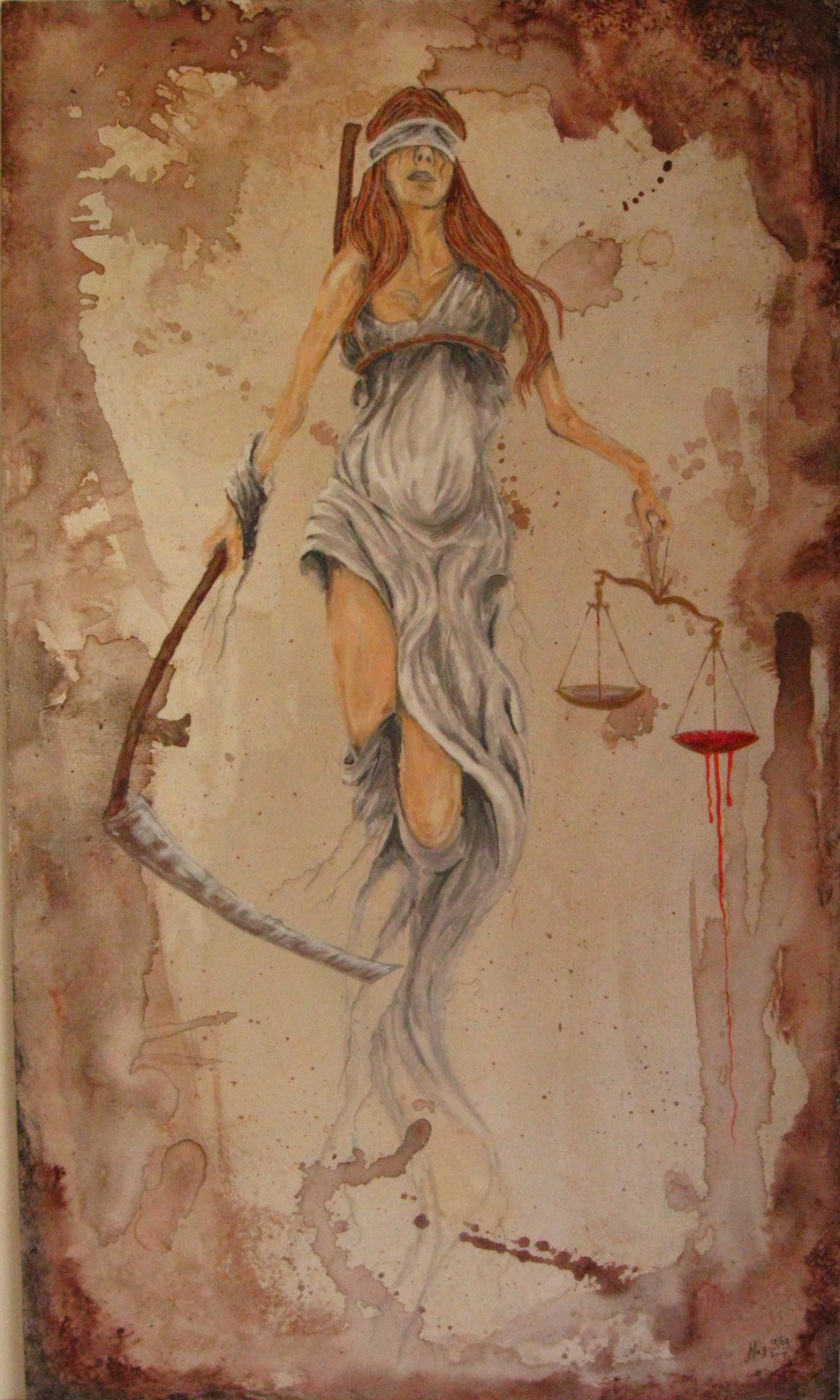
Eunomia and Eirene are also part of the Horae. Dike is depicted as being in continuous conflict with Adikia to keep humans from dissolving into chaos and wrongdoing. In some pictures, Adikia is shown trying to flee from Dike who is attacking her with a mallet.
EUNOMIA was the goddess of good order and lawful conduct. She was associated with the internal stability of a state, including the enactment of good laws and the maintenance of civil order. She was also the spring-time goddess of green pastures (nomia in Greek). Eunomia was one of the Horai (Horae), goddesses of the seasons and the keepers of the gates of heaven. Her sisters were the goddesses Dike (Justice) and Eirene (Peace). Her opposite number was Dysnomia (Lawlessness).
She was frequently depicted in Athenian vase painting amongst the companions of Aphrodite, and in this sense represented the lawful or obedient behaviour of women in marriage. As such she was identified with Eurynome, mother of the Kharites (Charites, Graces).
EUNOMIA
»Eunomia and that unsullied fountain Dikē, her sister, sure support of cities; and Eirene of the same kin, who are the stewards of wealth for humanity — three glorious daughters of wise-counselled Themis«
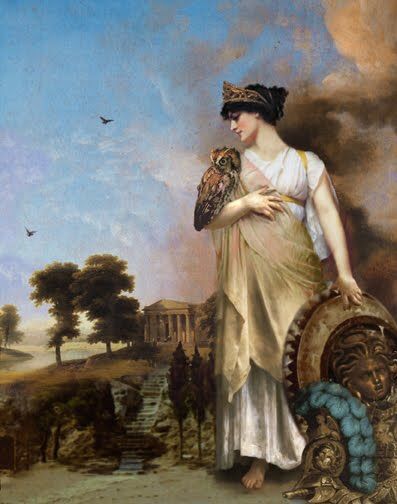
Eunomia is the minor goddess over law and legislation. And according to the most people a daughter of Themis(Θέμις) titaness over divine law, and Zeus. Her opposite was Dysnomia (Δυσνομία), Lawlessness.
The name Eunomia can be translated into ‘good order’ or ‘governance according to good laws’
She was frequently depicted in Athenian vase painting amongst the companions of Aphrodite, and in this sense represented the lawful or obedient behavior of women in marriage. As such she was identified with Eurynome, mother of the Charites (Graces).
Eirene more commonly known in English as Peace, who was the personification of peace. She was depicted in art as a beautiful young woman carrying a cornucopia, sceptre, and a torch or rhyton. She is said sometimes to be the daughter of Zeus and Themis. Her Roman equivalent was Pax.
She was particularly well regarded by the citizens of Athens. After a naval victory over Sparta in 375 BC, the Athenians established a cult for Peace, erecting altars to her. They held an annual state sacrifice to her after 371 BC to commemorate the Common Peace of that year and set up a votive statue in her honour in the Agora of Athens. The statue was executed in bronze by Cephisodotus the Elder, likely the father or uncle of the famous sculptor Praxiteles. It was acclaimed by the Athenians, who depicted it on vases and coins.
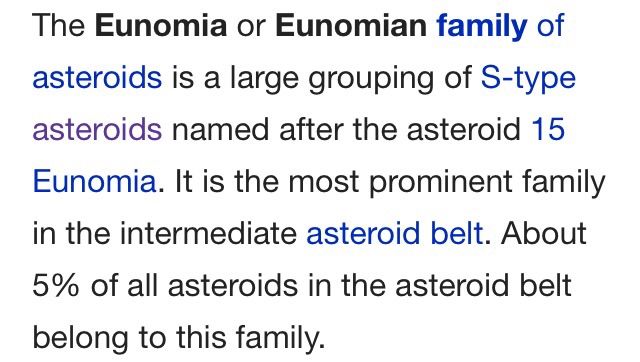
–
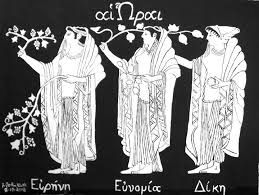
Horea was originally the personifications of the order of nature and of the seasons, but in later times they were regarded as the goddesses of order in general and of justice. In Homer, who neither mentions their parents nor their number, they are the Olympian divinities of the weather and the ministers of Zeus; and in this capacity they guard the doors of Olympus, and promote the fertility of the earth, by the various kinds of weather they send down.
The second generation do be fathered by Zeus and their mother should be Themis. Zeus is the king and Themis is titaness of Divine law, so it is pretty obvious that their children is law and order goddesses.
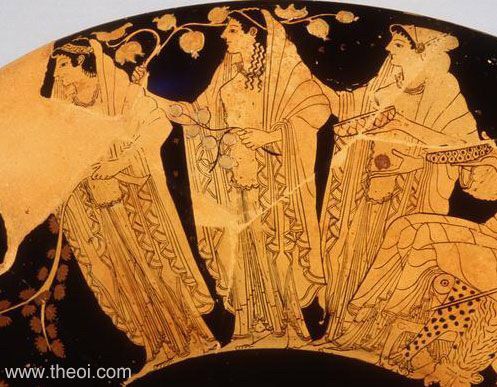

he horae and Dionysus}
According to Hesiod, Dike was fathered by Zeus upon his second consort, Themis. She and her mother were both personifications of justice. She is depicted as a young, slender woman carrying a physical balance scale and wearing a laurel wreath while her Roman counterpart (Justitia) appears in a similar fashion but blind-folded. She is represented in the constellation Libra which is named for the Latin name of her symbol (Scales). She is often associated with Astraea, the goddess of innocence and purity. Astraea is also one of her epithets referring to her appearance in the nearby constellation Virgo which is said to represent Astraea. This reflects her symbolic association with Astraea, who too has a similar iconography.
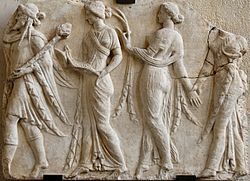
TRANSLATION
The House of Theseus, mosaic with the Three Horae (Dike, Eunomia and Eirene), West Wing, Paphos Archaeological Park, Cyprus

The great works of many PRE-SOCRATIC Greek philosophers have been lost to the sands of time. The best reconstructions we have, are from historians like DIOGENES Laertius, ARISTOTELES, and THEOFRASTUS. The latter brings us much of what we know about ANAXIMANDER.Burnet suggests that THEOFRASTUS had an insight into ANAXIMANDERs book, as he quotes him several times, and he occasionally criticizes him. Other sources include books such as the Refutation of All Heresies by the early Christian writer HIPPOLYTOS who claims that ANAXIMANDER was the FIRST to use the pre-existing word APEIRON
